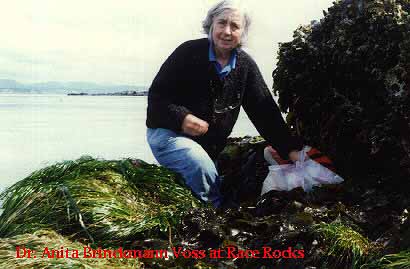 Dr. Anita Brinckmann-Voss passed away in December of 2017.
Dr. Anita Brinckmann-Voss passed away in December of 2017.
From 1986, to 2005, Dr. Brinckmann-Voss of Sooke, BC assisted the students and faculty of Lester Pearson College with her understanding of marine invertebrate ecology and her expertise in the taxonomy of hydroids. These small colonial animals, the alternate stage of the life-cycle of jellyfish, occur in rich profusion underwater at the Race Rocks Marine Ecological Reserve. When the original species list was done for the Race Rocks Ecological Reserve Proposal, in 1979, only 2 hydroids had been included on our species list. Now over 60 species have been identified by Anita and she continued to assist students with research projects while she furthered her research on specimens from the island until 2004. Anita has established long term research plots in a tidepool at the reserve and documents the distribution of hydroids underwater with the assistance of students and faculty in the Diving program at Lester B. Pearson College. Below: Anita accompanied Garry, Chris and Joe on a dive to Secretary Island, West of Race Rocks up the Strait of Juan de Fuca towards Sooke. The purpose was to collect samples for hydroid specimens.
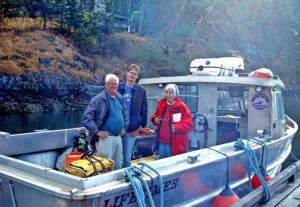 Dr. Armin Svoboda and his son Hanno visited Race Rocks with Chris Blondeau and Dr. Anita Brinckmann-Voss in August of 2004. His pictures taken on a dive there are linked here.
Dr. Armin Svoboda and his son Hanno visited Race Rocks with Chris Blondeau and Dr. Anita Brinckmann-Voss in August of 2004. His pictures taken on a dive there are linked here.
See this link for the hydroids identified by Anita. https://www.racerocks.ca/tag/hydroid/
See all the posts on this website tagged with Dr. Anita Brinckmann-Voss
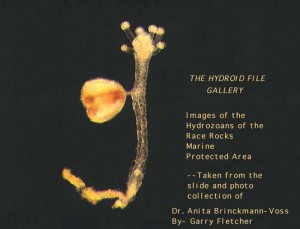 Gallery of photomicrographs of Hydroids- photos by Dr. Anita Brinckmann-Voss
Gallery of photomicrographs of Hydroids- photos by Dr. Anita Brinckmann-Voss
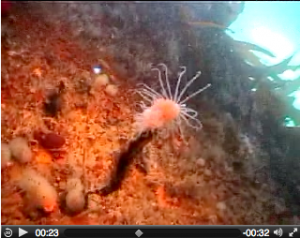 Video on the habitat of a rare Tubularia
Video on the habitat of a rare Tubularia
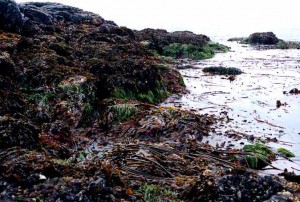 Photos of Intertidal Hydroid Habitat on West side of Race Rocks .
Photos of Intertidal Hydroid Habitat on West side of Race Rocks .
PUBLICATIONS of Dr. Voss from her Research at Race Rocks Ecological Reserve :
1. Brinckmann-Voss, A. , Lickey, D.M. , and Mills, C.E. 1993 . Rhysia fletcheri (Cnidaria, Hydrozoa, Rhysiidae), a new species of Colonial Hydroid from Vancouver Island British Columbia, Canada) and the San Juan Archipelago (Washington, USA) . Canadian Journal of Zoology 71: 401-406
Abstract:
- A new species of colonial athecate hydroid, Rhysia fletcheri , is described from Vancouver Island, British Columbia, Canada, and from Friday Harbour, Washington, U.S.A. It’s relationship to Rhysia autumnalis Brinckmann from the Mediterranean and Rhysia halecii (Hickson and Gravely) from the Antarctic and Japan is discussed. Rhysia fletcheri differs from Rhysia autumnalis and Rhysia halecii in the gastrozooid having distinctive cnidocyst clusters on its hypostome and few, thick tentacles.
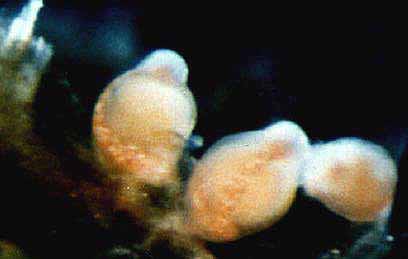 Most of its female gonozooids have no tentacles. Colonies of R. fletcheri are without dactylozooids. The majority of R. fletcheri colonies are found growing on large barnacles or among the hydrorhiza of large thecate hydrozoans.
Most of its female gonozooids have no tentacles. Colonies of R. fletcheri are without dactylozooids. The majority of R. fletcheri colonies are found growing on large barnacles or among the hydrorhiza of large thecate hydrozoans. - Rhysia fletcheri occurs in relatively sheltered waters of the San Juan Islands and on the exposed coast of Southern Vancouver Island. Colored photos of Rhysia males. females and gastrozooids are included.
2. Brinckmann-Voss, A. 1996. Seasonality of Hydroids (Hydrozoa, Cnidaria) from an intertidal pool and adjacent subtidal habitats at Race Rocks, off Vancouver Island,Canada, Scientia Marina Advances in Hydrozoan Biology , Vol 60 (1):89-97
Abstract:
- An assemblage of 27 hydroid species was reported from a tide pool in the lower rocky intertidal zone, and compared with 42 hydroids of the adjacent subtidal region. Location of hydroids within the pool, seasonal occurrence, growth and sexual maturity were tabulated, and some systematic aspects discussed. Possible causes of hydroid species diversity were considered, including location of the tide pool in an area of tidal rapids, and shading by surf-grass and rock cliffs during low tide.